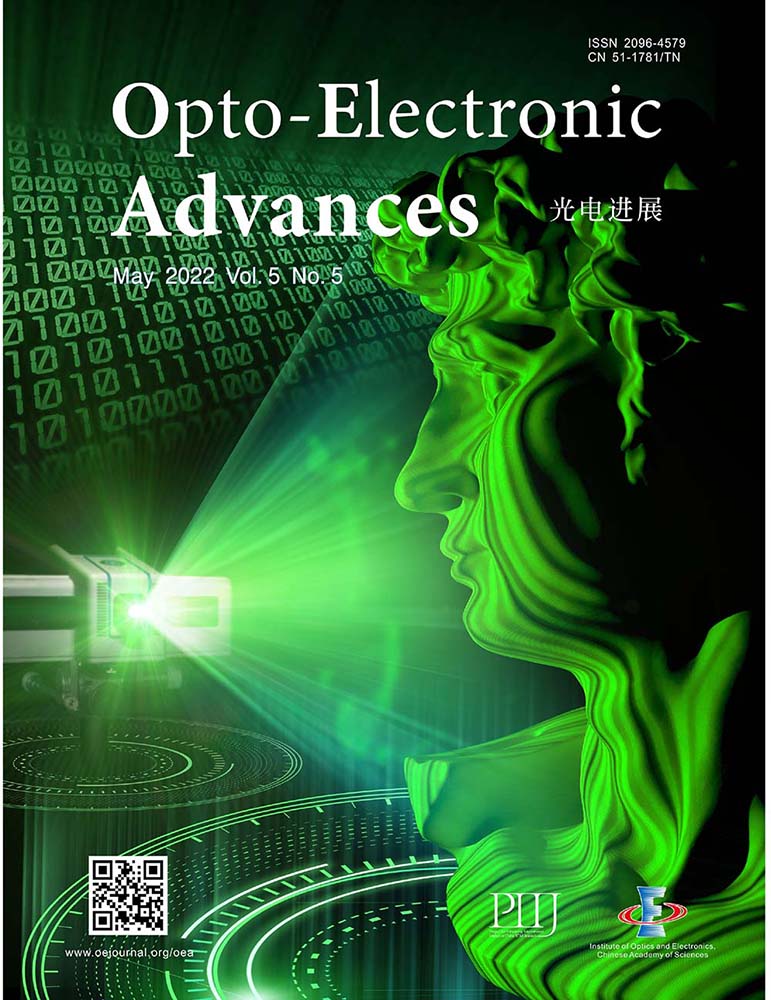- Opto-Electronic Advances
- Vol. 6, Issue 12, 230172 (2023)
Abstract
However, obtaining high-quality absolute phase information remains challenging due to variations in reflectance, shadows, and high directional gradients in shape. Also, the depth of a measured 3D scene (a measurement range) is limited. The authors emphasize their plans to explore advanced network structures and integrate more suitable physical models into deep learning networks to achieve higher speed, accuracy, and robustness in 3D shape measurement using fewer neural networks or in an end-to-end manner. These AI based enhancements can be assisted by modification of the measurement scenario followed by the proposed DCFPP processing scheme. In
Such measurement and processing scenario could be investigated to minimize directional errors including reduction of the influence of variations of reflectance and occurrence of shadows in an object.
![]()
Figure 1.
High-speed and high-precision 3D imaging has become a crucial aspect of numerous scientific and industrial applications
To solve the phase ambiguity problem, Takeda et al.
New concept in FPP based SL considers implementation of deep learning based frameworks to solve intensity-phase domain transition problem
![]()
Figure 2.Possible future extension of the proposed DCFPP technique: (
In comparison to the traditional Fourier transform method, the presented approach mitigates the reduced 3D measurement accuracy caused by spectrum aliasing resulting from generally low spatial frequency of the projected double-frequency pattern. The proposed method achieves performance similar to that of the traditional 12-step phase-shifting method, which is a remarkable result for a single-shot approach. The study demonstrates the efficacy of deep learning in synthesizing both temporal and spatial information, effectively addressing the spectrum-aliasing problem. The article concludes that this approach overcomes the limitations of traditional multi-frequency composite methods and single end-to-end deep learning networks. The utilization of two joined networks proves advantageous as it decomposes the problem into two lines, aligning with the inherent working principle of networks that decompose problems into subsets of convolutional layers.
Another promising avenue for future research involves merging information from other modalities, such as digital image correlation, to enable dynamic 3D shape and displacement mapping
Nevertheless, high-precision 3D reconstruction using only one single pattern has been the ultimate goal of structured light 3D imaging in perpetual pursuit. Fourier transform profilometry (FTP)
References
[1] S Zhang. High-speed 3D shape measurement with structured light methods: a review. Opt Lasers Eng, 119-131(2018).
[2] XY Su, QC Zhang. Dynamic 3-D shape measurement method: a review. Opt Lasers Eng, 191-204(2010).
[3] J Geng. Structured-light 3D surface imaging: a tutorial. Adv Opt Photonics, 128-160(2011).
[4] SS Gorthi, P Rastogi. Fringe projection techniques: whither we are. Opt Lasers Eng, 133-140(2010).
[5] R Sitnik, M Kujawińska, JM Woźnicki. Digital fringe projection system for large-volume 360-deg shape measurement. Opt Eng, 443-449(2002).
[6] C Zuo, SJ Feng, L Huang, TY Tao, W Yin et al. Phase shifting algorithms for fringe projection profilometry: a review. Opt Lasers Eng, 23-59(2018).
[7] M Takeda, K Mutoh. Fourier transform profilometry for the automatic measurement of 3-D object shapes. Appl Opt, 3977-3982(1983).
[8] C Zuo, L Huang, ML Zhang, Q Chen, A Asundi. Temporal phase unwrapping algorithms for fringe projection profilometry: a comparative review. Opt Lasers Eng, 84-103(2016).
[9] M Pirga, M Kujawinska. Two directional spatial-carrier phase-shifting method for analysis of crossed and closed fringe patterns. Opt Eng, 2459-2466(1995).
[10] M Takeda, Q Gu, M Kinoshita, H Takai, Y Takahashi. Frequency-multiplex Fourier-transform profilometry: a single-shot three-dimensional shape measurement of objects with large height discontinuities and/or surface isolations. Appl Opt, 5347-5354(1997).
[11] ZH Zhang. Review of single-shot 3D shape measurement by phase calculation-based fringe projection techniques. Opt Lasers Eng, 1097-1106(2012).
[12] C Zuo, JM Qian, SJ Feng, W Yin, YX Li et al. Deep learning in optical metrology: a review. Light Sci Appl, 39(2022).
[13] SJ Feng, Q Chen, GH Gu, TY Tao, L Zhang et al. Fringe pattern analysis using deep learning. Adv Photonics, 025001(2019).
[14] W Yin, Q Chen, SJ Feng, TY Tao, L Huang et al. Temporal phase unwrapping using deep learning. Sci Rep, 20175(2019).
[15] JM Qian, SJ Feng, TY Tao, Y Hu, YX Li et al. Deep-learning-enabled geometric constraints and phase unwrapping for single-shot absolute 3D shape measurement. APL Photonics, 046105(2020).
[16] der Jeught S Van, JJJ Dirckx. Deep neural networks for single shot structured light profilometry. Opt Express, 17091-17101(2019).
[17] M Cywińska, F Brzeski, W Krajnik, K Patorski, C Zuo et al. DeepDensity: convolutional neural network based estimation of local fringe pattern density. Opt Lasers Eng, 106675(2021).
[18] M Cywińska, M Rogalski, F Brzeski, K Patorski, M Trusiak. DeepOrientation: convolutional neural network for fringe pattern orientation map estimation. Opt Express, 42283-42299(2022).
[19] ZS Li, JS Sun, Y Fan, YB Jin, Q Shen et al. Deep learning assisted variational Hilbert quantitative phase imaging. Opto-Electron Sci, 220023(2023).
[20] M Cywińska, K Szumigaj, M Kołodziej, K Patorski, V Mico et al. DeepVID: deep-learning accelerated variational image decomposition model tailored to fringe pattern filtration. J Opt, 045702(2023).
[21] YX Li, JM Qian, SJ Feng, Q Chen, C Zuo. Deep-learning-enabled dual-frequency composite fringe projection profilometry for single-shot absolute 3D shape measurement. Opto-Electron Adv, 210021(2022).
[22] H Nguyen, YZ Wang, ZY Wang. Single-shot 3D shape reconstruction using structured light and deep convolutional neural networks. Sensors, 3718(2020).
[23] VI Gushov, YN Solodkin. Automatic processing of fringe patterns in integer interferometers. Opt Lasers Eng, 311-324(1991).
[24] A Papanikolaou, D Dzik-Kruszelnicka, M Kujawinska. Spatio-temporal monitoring of humidity induced 3D displacements and strains in mounted and unmounted parchments. Herit Sci, 15(2022).

Set citation alerts for the article
Please enter your email address



